Crafting the future

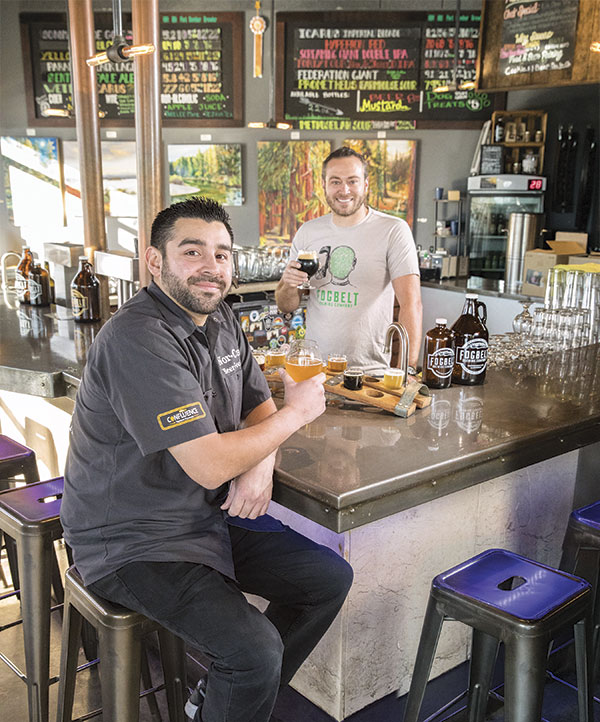
Peter Lopez Jr., co-founder of NorCal Beer Geeks, left, joins Paul Hawley, a hop grower and owner of Fogbelt Brewing Co., in raising a glass to the future of California hops. Photo: © 2018 Steven Knudsen
Hop vines sprout up wild in Sonoma County along riverbeds and near century-old hop kilns, the barns where the small, aromatic green flowers used in making beer are dried. For hop growers Paul Hawley and Mike Stevenson, the plants are a reminder that, long before their home county earned a reputation as a world-class wine producer, hops were the king of its crops.
"My grandmother remembers picking hops along the Russian River as a girl," Hawley said.
He and Stevenson are among a new wave of small-scale hop farmers in California who aim to revive the state's hop-growing history for the benefit of a growing number of craft beer lovers. Now, each is nurturing nearly 400 hop plants on his own farm. Though their hop yards may at first resemble grids of upright poles, cables and twine, by late spring that twine will be covered with hop vines, called bines, reaching high into the sky.
The scene was once common in Sonoma County, which formerly reigned as one the nation's largest producers of quality hops due to its climate, soils and available water. In the early 1900s, hops were also grown extensively throughout Mendocino, Lake and Sacramento counties. California hop farmers survived Prohibition by shipping to international markets. But following the repeal of Prohibition, commercial hop production shifted to the Pacific Northwest, where favorable growing conditions and the invention of a mechanized harvester allowed large-scale farms to thrive. Today, most of the nation's hops are still grown in Washington, Oregon and Idaho.
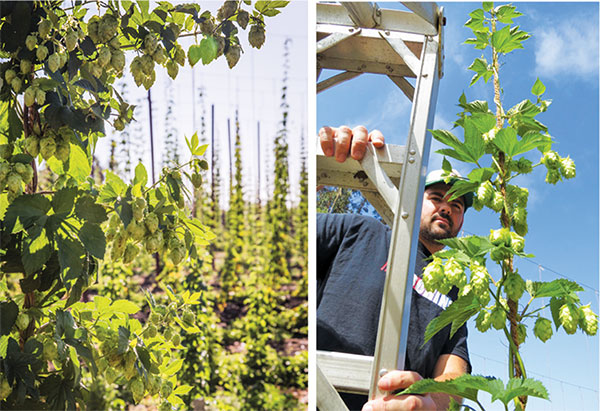
Mike Stevenson, co-founder of the NorCal Hop Growers Alliance, checks the hop flowers, or cones, on his plants, right. The plants, left, can reach heights of 20 to 25 feet by the time they're harvested in late summer. Photo at left courtesy of Fogbelt Brewing Co. Photo at right courtesy of Warm Spring Wind Hop Farm
California-grown hops
Now, California's burgeoning craft beer scene is reigniting interest in growing the flavorful flowers in the state. California is the birthplace of the American craft beer movement, supporting about 850 craft breweries—more than any other state—and producing about one in every five craft beers made in the U.S., according to the California Craft Brewers Association.
Hops, one of the main ingredients in beer, lend a bitter counterpoint to the brew's sweet malts and are essential to shaping its unique character. Craft brewers use different varieties—both fresh and dried—to achieve distinct flavors and add floral, fruity aromatics to set their brews apart.
"The craft beer industry is growing so fast that brewers are pushing hard to do something unique to differentiate themselves," Stevenson said, adding that there is an emphasis on using locally grown hops, grain and even water.
The explosion in the number of craft brewers has put pressure on worldwide hop supplies, leading to fierce competition among brewers vying for quality hops, and even shortages.
"The more California hops that we can grow, the more we can supply to craft brewers," Hawley said. "Craft brewers are always experimenting with ingredients such as hops to make unique beers, and consumers love to try them."
Hawley and Stevenson each farm about a quarter acre of hops, including popular varieties such as Cascade, as well as experimental varieties. Stevenson sells his hops from Warm Spring Wind Hop Farm to local brewers and uses them in his home brewing. Hawley uses his crop in beers he makes at Fogbelt Brewing Co., a Santa Rosa brewery he opened in 2014.
Together, the men formed the NorCal Hop Growers Alliance, a group of hop growers and brewers dedicated to supporting and promoting local hop farming and craft beer. They join growers in Southern California, including about a dozen hop farmers of the San Diego Hop Growers Association, in making a name for California-grown hops.
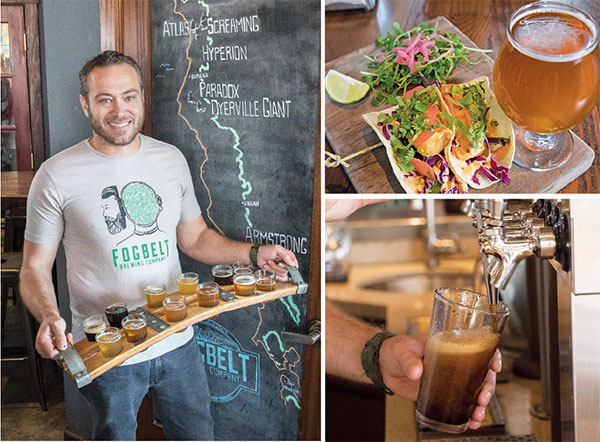
Paul Hawley offers several craft beers on tap and food to accompany it at Fogbelt Brewing Co. in Santa Rosa. Photos: © 2018 Steven Knudsen
Beers show local character
As with winegrapes, the microclimates and soils where hops are grown produce different flavors, just as different vineyards produce distinctive-tasting wines from the same grape varietal. The French call this concept of regional variations "terroir."
"There's a movement of people who are approaching beer like wine, appreciating its aromas and tastes based on the origins of its ingredients," Stevenson said.
He supplies hops to a Napa Valley brewer who subscribes to that notion of terroir, producing a series of single-origin beers using only ingredients from specific counties, including Sonoma.
"Showcasing a beer's origin adds to its authenticity and uniqueness of character," said Mad Fritz brewer Nile Zacherle.
Peter Lopez Jr., owner of the Santa Rosa taproom Confluence, agrees. He's co-founder of a growing group of craft beer enthusiasts called NorCal Beer Geeks, who "geek out" over hop varieties and origins.
"A good beer begins with the ingredients," he said. "You can't make good beer without quality hops, and people like knowing where they're grown."
A former judge for beer competitions who features a revolving list of Northern California craft beers in his taproom, Lopez said he appreciates the quality of hops in beers such as Fogbelt's, and the efforts that people such as Hawley and Stevenson put into promoting locally grown hops.
"People in this region love hoppy beer," Lopez said, pointing out that spring is the time when people often gravitate from dark, malty beers toward lighter, hoppy brews. "Regardless of the time of year, at least half of our featured beers will be hop-driven."
Sonoma County's preeminence as a wine region hasn't hampered local demand for craft beer—about 30 of Northern California's roughly 150 craft breweries are based in the county.
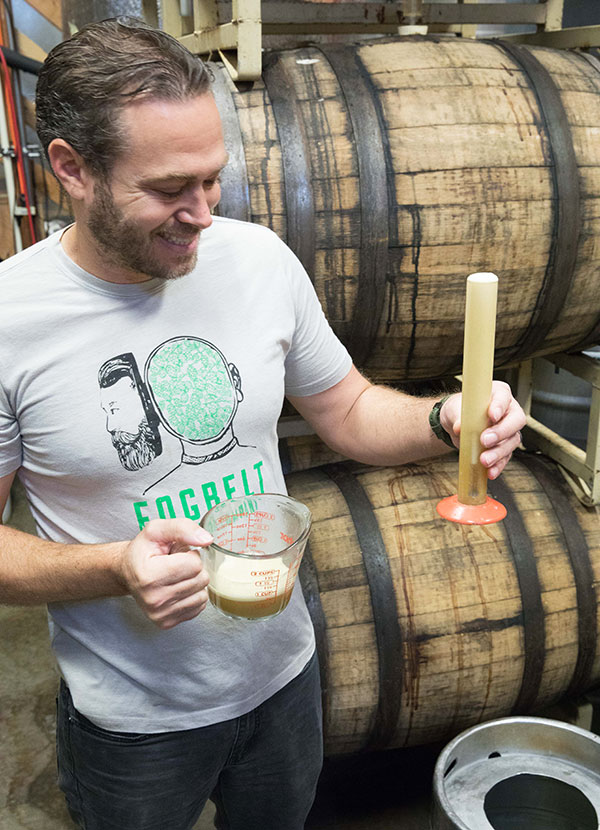
Paul Hawley and his business partner have been brewing together since 2004. Photo: © 2018 Steven Knudsen
Farm-to-kettle brewing
Playing to the palates that enjoy hop-forward beers, many craft brewers create seasonal "wet-hopped" beers. These beers are distinguished by the fresh hops harvested hours before their use, rather than hops that have been dried and preserved. Fresh hops contribute to the beverage's earthy and fruity qualities.
"The key to great wet-hopped beer is the freshness of the hops," Fogbelt's Hawley said. "And you can't get anything fresher than locally grown."
Brewers often visit a hop farm just before harvest to survey the hops, then coordinate their brewing schedule with the grower so that hops can be tossed into the kettle within hours of picking.
Wet-hopped beers are Hawley's favorite to brew and drink: "It's like cooking with fresh herbs instead of dried," he said.
The wet-hop niche represents the biggest window of opportunity for California-based hop growing. The crop can be grown virtually anywhere in the state, meaning that more local hop farms may be on the horizon, creating deeper connections between producer and consumer.
Local beer aficionado Jeff Bull, a Santa Rosa home brewer and blogger, said a vibrant beer culture can encourage a sense of community.
"I've met so many people over a beer at a local taproom," he said. "There's a strong sense of pride in local beers and their history here. When someone uses fresh, locally grown hops, it has a positive impact on the beer, both in the way it tastes and how people feel about it."
If the local craft beer culture is any indication, the future for hop growing in the region is bright.
"Sonoma County is blessed with amazing growing conditions," Lopez said. "Sonoma's wine industry has taken center stage for so long, it's encouraging to see people going back to the roots of the region—growing their own hops and making beer from hops produced here."
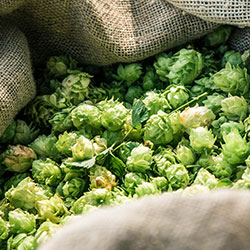
Hops are harvested in August or September in California. Photo courtesy of Fogbelt Brewing Co.
Beer garden growing your own hops
If you're a home brewer and enjoy gardening, you might consider growing your own hops. Here are several things to know before taking the leap:
- Although hop plants can be grown throughout California, they are picky about where they're planted. They thrive in sunny locations with plenty of water and well-drained soil.
- Hop plants can be planted from underground stems called rhizomes, which grow new roots and shoots that develop into new hop plants, or bines, in the spring.
- Hops are hardy perennials. Established hop bines die back to their roots every year and send up new shoots from their root crown in April.
- By May, the spiny tendrils of hop plants are trained to climb onto twine strung from 18-foot-tall poles, spaced several feet apart. The bines begin flowering in midsummer.
- Hop bines grow quickly—up to 6 to 8 feet in a three-week period—and can reach heights of 20 to 25 feet at harvest.
- The bine produces hop cones (cone-shaped flowers) used to make beer. Hops are harvested in August or September in California.
- At harvest time, the hop cones are removed from the bines for use either as fresh or dried hops. Hop cones can be dried, ground and pressed into hop pellets for use by brewers throughout the year.
- It takes about three years for a hop plant to reach full maturity and maximum hop production.
Sources: University of California Cooperative Extension, Sonoma County; Paul Hawley, Fogbelt Brewing Co.

